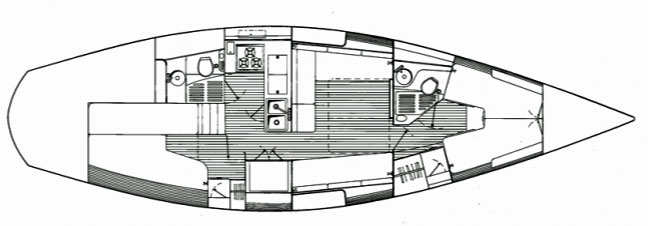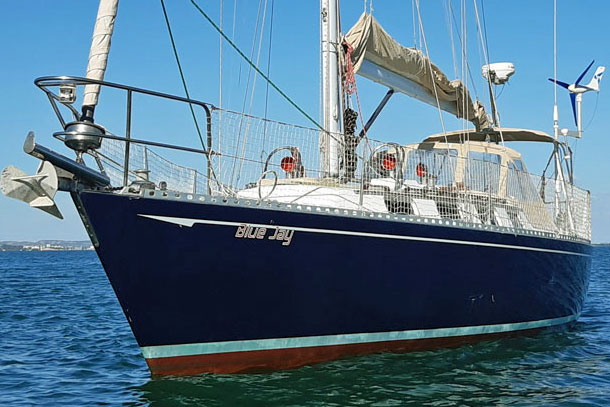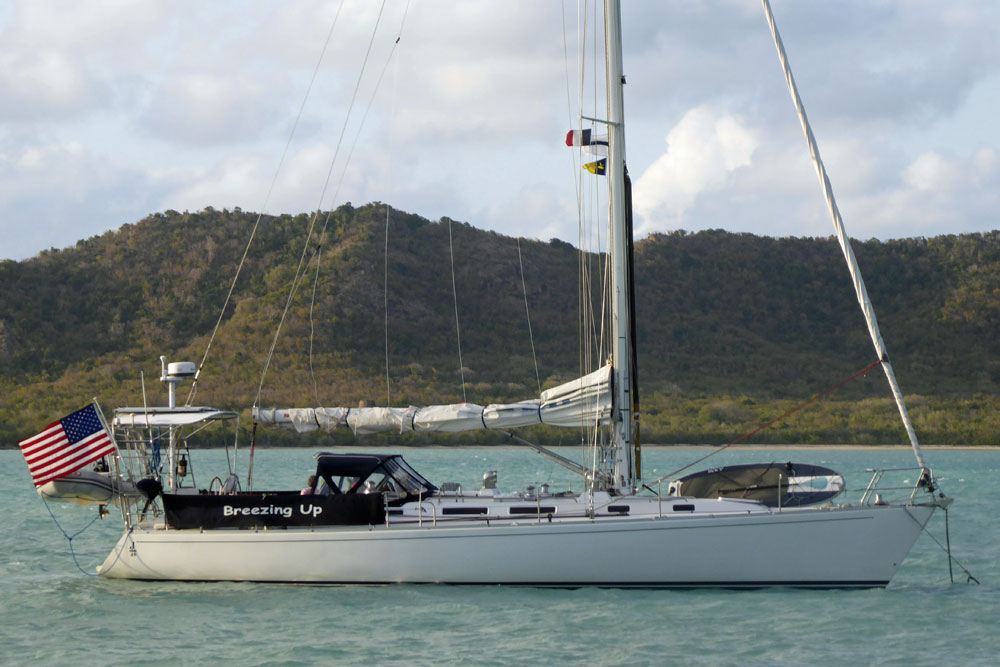The J40 Sailboat
Specs & Key Performance Indicators
The J40, a performance cruising boat, was designed by Rod Johnstone and built in the USA by Tillotson-Pearson.
Published Specification for the J40
Underwater Configuration: Fin Keel & Spade Rudder
Hull Material: GRP (Fiberglass)
Length Overall: 40'0" (12.2m)
Waterline Length: 34'0" (10.4m)
Beam: 12'2" (3.7m)
Draft: 6'6" (2.0m) - deep draft version, 5'6" (1.7m) - shallow draft fin keel version, 5'5" (1.6m) - wing keel version.
Rig Type: Masthead Sloop
Displacement: 18,000lb (8,165kg)
Designer: Rod Johnstone
Builder: Tillotson-Pearson
Year First Built: 1984
Year Last Built: 1994
Number Built: 86
Published Design Ratios for the J40
1. Sail Area/Displacement Ratio: 17.9
2. Ballast/Displacement Ratio: 36.1
3. Displacement/Length Ratio: 204
4. Comfort Ratio: 27.9
5. Capsize Screening Formula: 1.9
Summary Analysis of the Design Ratios for the J40
1. A Sail Area/Displacement Ratio of 17.9 suggests that the J40 will, in the right conditions, approach her maximum hull speed readily and satisfy the sailing performance expectations of most cruising sailors.
2. A Ballast/Displacement Ratio of 36.1 means that the J40 will have a tendency to heel excessively in a gust, and she'll need to be reefed early to keep her sailing upright in a moderate breeze.
3. A Displacement/Length Ratio of 204, tells us the J40 is clearly a light displacement sailboat. If she's loaded with too much heavy cruising gear her performance will suffer dramatically.
4. Ted Brewer's Comfort Ratio of 27.9 suggests that crew comfort of a J40 in a seaway is similar to what you would associate with the motion of a coastal cruiser with moderate stability, which is not encouraging news for anyone prone to seasickness.
5. The Capsize Screening Formula (CSF) of 1.9 tells us that a J40 would be a safer choice of sailboat for an ocean passage than one with a CSF of more than 2.0.
More about the J40...
The J40 was designed by Rod Johnstone and built by J Boats between 1984 and 1993. It was the first bluewater offshore cruising boat built by J Boats, and it has a loyal following of owners who appreciate its performance, comfort and quality.
 The J40 accommodation layout
The J40 accommodation layoutThe J40 is a sloop-rigged boat with a fin keel and a spade rudder. The sail area is 765 square feet, which gives it a sail area to displacement ratio of 18. The boat is powered by a 43 hp diesel engine.
The J40 has a sleek and elegant hull shape that is optimized for speed and stability. The boat can handle a variety of wind and sea conditions, and it has a reputation for being fast, responsive and easy to sail . The J40 has also proven itself in offshore racing, winning several awards and trophies under the ORR and PHRF handicap systems.
Accommodation
The J40 can accommodate up to six people in two separate cabins and the main saloon. The forward cabin has a V-berth with storage underneath, a hanging locker and a private head with shower. The aft cabin has a double berth, a hanging locker and access to the second head with shower. The main saloon has a U-shaped dinette to port that can convert into a double berth, and a settee to starboard that can serve as a single berth. The navigation station is located aft of the settee, facing outboard. The galley is located aft of the dinette, along the port side. It has a three-burner stove with oven, a double sink, a top-loading refrigerator and ample storage space.
The interior of the J40 is spacious, bright and well-ventilated. It has large windows, hatches and ports that provide natural light and fresh air. The woodwork is made of teak, which adds warmth and elegance to the cabin. The upholstery is durable and comfortable, and the cushions are thick and firm. The layout is practical and functional, with plenty of headroom, storage space and access to the engine and systems.
Hull and Deck
The hull of the J40 is made of fiberglass with balsa core for stiffness and insulation. The deck is also made of fiberglass with balsa core, except for high-stress areas where solid fiberglass is used. The hull-to-deck joint is bonded with adhesive and through-bolted with aluminum toe rail. The bottom is protected by an epoxy barrier coat to prevent osmosis.
The deck of the J40 is designed for safety and convenience. It has wide side decks, molded nonskid surfaces, stainless steel handrails and lifelines, and recessed hatches. The cockpit is large and comfortable, with high coamings, long seats, deep lockers and an integrated swim platform. The boat is steered by a single wheel mounted on a pedestal that also houses the engine controls, the compass and the instruments. The sail controls are led aft to the cockpit through organizers and clutches, making it easy to handle the boat single-handed or with a small crew.
This article was written with the assistance of Gemini, a large language model developed by Google. Gemini was used to gather information, summarize research findings, and provide suggestions for the content and structure of the article.
Other sailboats in the J-Boat range include:
Recent Articles
-
Albin Ballad Sailboat: Specs, Design, & Sailing Characteristics
Jul 09, 25 05:03 PM
Explore the Albin Ballad 30: detailed specs, design, sailing characteristics, and why this Swedish classic is a popular cruiser-racer. -
The Hinckley 48 Sailboat
Jul 09, 25 02:44 PM
Sailing characteristics & performance predictions, pics, specifications, dimensions and those all-important design ratios for the Hinckley 48 sailboat... -
The Hinckley Souwester 42 Sailboat
Jul 09, 25 02:05 PM
Sailing characteristics and performance predictions, pics, specifications, dimensions and those all-important design ratios for the Hinckley Souwester 42 sailboat...















